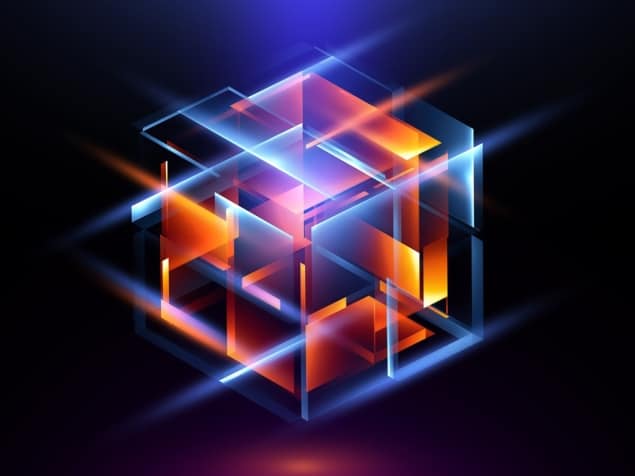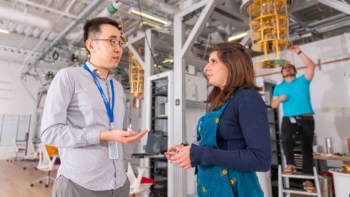
A practical implementation of a quantum error-correction protocol first proposed back in 2001 has been achieved by physicists in the US and France. The protocol increases the coherence time of quantum memory and although the work is still preliminary, it could potentially allow for the much more economical use of quantum bits (qubits) in quantum computers.
Noise is inevitable in any system, and conventional computers use error correction to stop noise from corrupting calculations. In quantum computers, noise-related errors are a much more significant problem because of the delicate nature of the quantum states used to create qubits.
Errors in a quantum computer come from fundamentally classical sources, explains Michel Devoret of Yale University in Connecticut: “The computation is derailed by parasitic noise or thermal noise.” However, fixing errors is not a simple matter. “When you are repairing errors, you may introduce new errors because measurement is invasive in quantum mechanics,” says Devoret.
Non-local solution
The key to overcoming this problem lies in the fact that noise is local – it does not affect different parts of a system in a non-random way. If quantum information is stored non-locally, therefore, it should be possible to recover it. Most quantum error-correction algorithms do this by using multiple qubits to encode the same information. This is not a panacea, however, because increasing the number of qubits in a quantum computer is not easy. For example, Google’s Sycamore machine, with which it claimed quantum advantage in 2019, contained just 54 qubits.
Back in 2001, theoretical physicists Daniel Gottesman, Alexei Kitaev and John Preskill proposed storing information non-locally in exotic quantum states of an oscillator that became known as GKP states. “Everybody knows that the uncertainty principle says you can’t measure with arbitrary precision both the position and the momentum of a harmonic oscillator,” explains Preskill, who is at Caltech. “But it turns out that you can prepare a state of a particle or an oscillator, then someone – while your back is turned – can come along and shift it a little in position and momentum, and you can measure both shifts to arbitrary accuracy if you promise that they are small. If you look at one of these states in position space it looks like a grid, and if you look at it in momentum space it looks the same way; so if you shift the comb by less than half the distance between the teeth, you can measure the distance by which it’s been shifted. So you can encode information in these states and the noise in the lab can be measured and corrected.”
“Visionary theoretical discovery”
When the trio first published their results, Devoret says the paper received only limited attention. “I find this paper to be a wonderful example of a visionary theoretical discovery happening a little too early,” he says. “I remember reading this paper and thinking ‘Well this looks very clever but not very practical’.”
Since 2001, however, researchers have become more adept at creating exotic quantum states in various platforms. Moreover, they have realized that, as well as correcting for small displacements in position and momentum, GKP states can also compensate more effectively than any other states for the much more significant noise arising from photon loss from qubit states.
Last year, researchers at ETH Zurich in Switzerland created GKP states in qubits made of trapped ions, which are a leading contender for practical quantum computers. Now, Devoret and colleagues at Yale and the Inria Paris Research Centre have demonstrated quantum error correction of an encoded qubit in the other leading quantum-computing technology – qubits made from superconducting circuits.
Double the lifetime
The researchers initialized qubits in specific states and measured their lifetimes with and without applying the quantum error-correction algorithm. They found that the error-correction algorithm doubled the lifetime of all the quantum states to around 250 μs. “In our experiment we’re just protecting memory,” says Devoret, “The next step is to show fault-tolerant computation: you want to protect an operation and error correct while you are computing.”
Preskill is impressed. “Until now they’ve only demonstrated a fairly modest improvement over what they can do without using these special error-resistant states,” he says, “but it’s an important step.”

The hard sell of quantum software
As John Martinis of University of California, Santa Barbara adds, “I think it’s a really interesting [achievement] and a step forward for the field because they made this error-protected logical qubit using ideas that have been around for a long time. They showed it worked.”
Martinis, who until recently worked at Google’s AI lab developing quantum computers, cautions however, that radical improvements may be necessary to compete with the brute force approach. “If you look at the technology of computers, we know that, over time, people learn how to make lots of bits – so we can make lots of qubits. The advantage here is that you do this error correction internally using one qubit with a complicated state, so you don’t necessarily have to scale up, but unless you extend the lifetime thousands or millions of times, how useful is it going to be?” he says.
The research is described in Nature.



